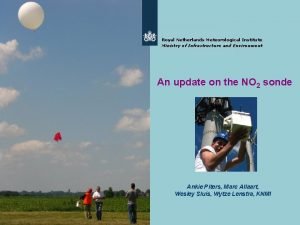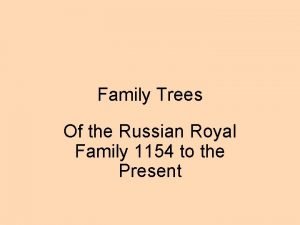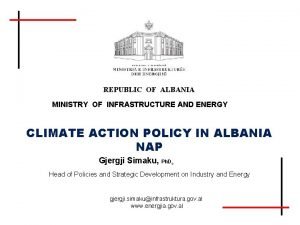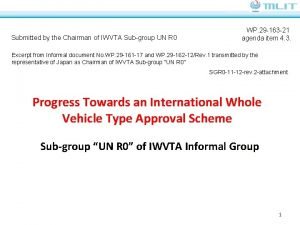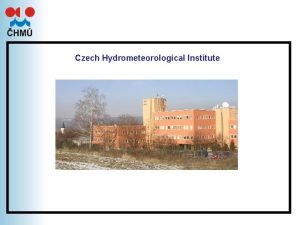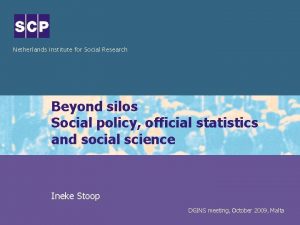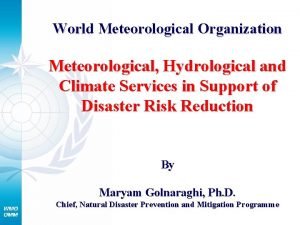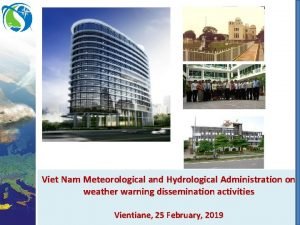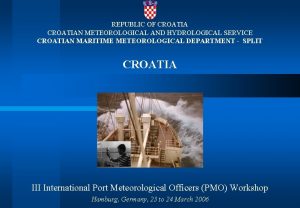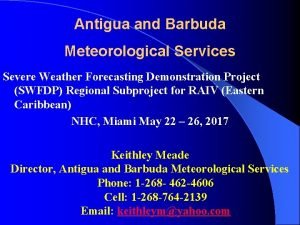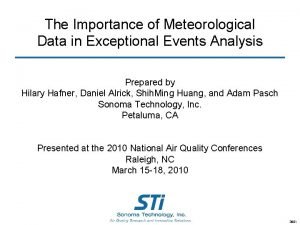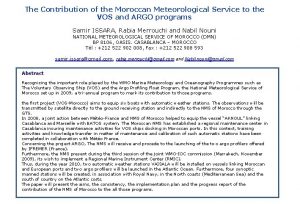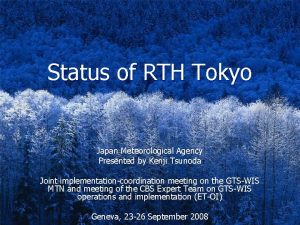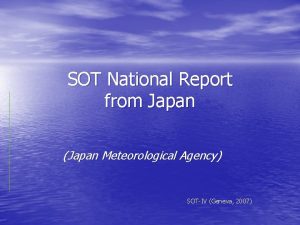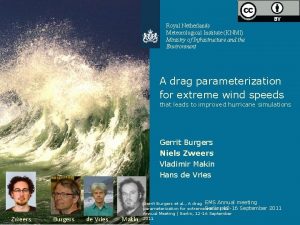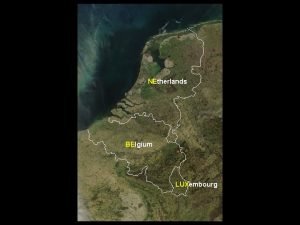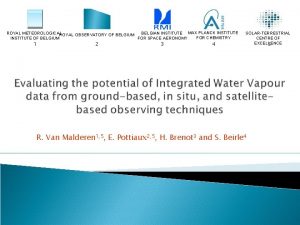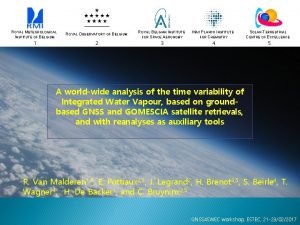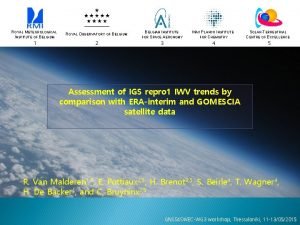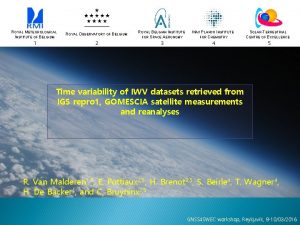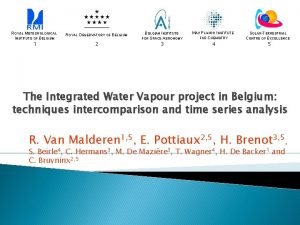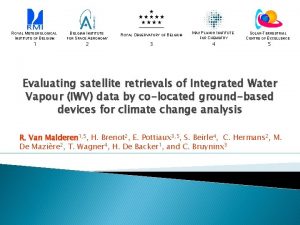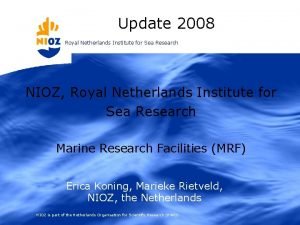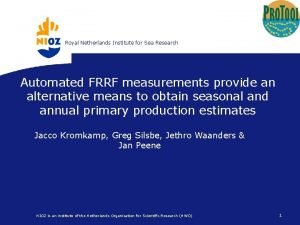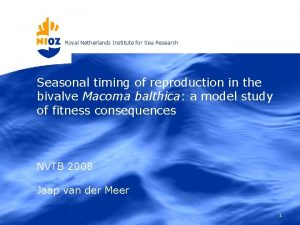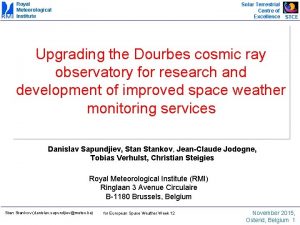Royal Netherlands Meteorological Institute Ministry of Infrastructure and





















- Slides: 21

Royal Netherlands Meteorological Institute Ministry of Infrastructure and Environment. ATLID L 2 a Extinction Backscatter and Depolarization Profile (APRO) Algorithms. D. P. Donovan 1, Gerd-Jan van Zadelhoff 1, J. E. Williams 1, U. Wandinger 2 1 Royal Netherlands Meteorological Institute (KNMI), Utrecht, Netherlands, Institute for Tropospheric Research. Leipzig, Germany 2 Leibniz 1

Processor A-PRO (ATLID Profile processor) Input Products 1. Feature. Mask 2. ATLID L 1 3. Auxiliary Met data Output Products (reported on Joint standard Grid grid) 1. Aerosol and cloud optical properties. 2. Target Classification 3. Aerosol type Royal Netherlands Meteorological Institute Ministry of Infrastructure and Environment. Brief Description • Two Step approach to deriving optical properties: 1. “Conventional” HSRL techniques applied to smoothed fields. 2. High resolution “Optimal Klett-like” retrievals aimed at clouds. • Cloud/aerosol discrimination and aerosol typing based on using Backscatter thresholds as well as S and linear depolarization ratio. • Cloud phase determination via layer integrated backscatter-vs-integrated depolarization ratio. 1/17/2022 2

A-EBD: Optimal-Estimation: Hybrid Mie-Rayleigh High-resolution Extinction Retrieval • Goal is to find the “best” Klett-like inversion that yields an extinction and S profile that allows one to best match the observed Rayleigh signal. • Cast in an optimal estimation framework. • Priors are a combination of expected values and S values derived by the conventional HSRL inversion (pervious step). • Multiple-scattering effects are accounted for. 1/17/2022 3

A simple approach for dealing with Multiple-Scattering 1/17/2022 4

Target Classification (A-TC) -Cloud/Aerosol separation based on combination of thresholds and, in the case of thin-ice-vs-aerosol, depol. and lidar-ratio Cloud phase based on integrated depol. -vsintegrated attenuated backscatter 1/17/2022 Aerosol type based on depol. -vs-lidar-ratio U. Wandinger has formalized a scheme for ECARE 5 using certain base aerosol classes.

Some Examples based on simulated scenes • Scenes have been built using ECSIM using Environment Canada’s high-res global NWP model run at 0. 25 km hor. res. • Clouds/precip. are handled by a twomode bulk scheme (Milbrandt-Yau) • No Aerosols in provided fields Merge with ECMWF CAMS fields. Example (Halifax Scene) 1/17/2022 6

1/17/2022 7

Model Extinction Field Results are good but can and will improve ! (e. g. , there may be biases present) Retrieved Cloud and Aerosol Extinction 1/17/2022 -Averaging intervals ? -Improper screening ? -a-prior weightings ? -Bugs ? 8

Recent Example of a PSC scene built using CALIPSO/CSAT retrievals ATLID signals generated using CSAT/CALIPSO retrieval products as a basis for a ECSIM scene. Retrieved particulate extinction A-TC output with stratospheric types implemented. 1/17/2022 9

Summary • A multi-scale approach is required. – Identify “strong-features” at as high a resolution as possible – Smooth over weak (e. g. aerosol and thin cloud) features. This then allows one to apply direct methods. – Output from above provide constraints for high resolution retrievals of both cloud and aerosols. • Retrieved S and depol. cloud-phase and aerosol typing. • ATLID specific algorithm has been coded for operation processing – As well as using simulations, certain code modules and many of the concepts are being tested using ALADIN data. 1/17/2022 10

1/17/2022 11

Backup Slides 1/17/2022 12

A-EBD: Optimal-Estimation: Hybrid Mie-Rayleigh High-resolution Extinction Retrieval • Goal is to find the “best” Klett-like inversion that yields an extinction and S profile that allows one to best match the observed Rayleigh signal. • Cast in an optimal estimation framework. • Priors are a combination of expected values and S values derived by the conventional HSRL inversion (pervious step). • Multiple-scattering effects are accounted for. 1/17/2022 13

Aerosol Models Coarse mode: Dust Coarse mode: Sea salt Fine mode: Weakly absorbing Fine mode: Strongly absorbing reff, µm 1. 94 0. 14 m. R 1. 56 1. 40 1. 50 1. 53 1. 36 1. 45 1. 55 0. 005 0. 003 0. 043 m. I 0. 003 Shape S, sr , % 0 1/17/2022 0. 030 Dubovik’s spheroid distribution Spherical 10% prolates with axis ratio 1. 1 100% prolates with axis ratio 1. 1 72. 5, 13. 3 78. 3 116. 9 63. 7 17. 1 63. 0 74. 6 22. 8 0. 0 26. 0 3. 7 2. 2 1. 7 0. 81 1. 00 0. 98 0. 81 0. 87 1. 00 0. 98 0. 86 14

A-PRO Components ATLID-only Aerosol Extinction, Backscatter and Type (A-AER): -Adaptively averages “non-cloud” signals to derive large hor. scale (10 -100 km) aerosol properties. -Aerosol classification based on depol, S etc. . as well as geography etc. ATLID-only HRSL Extinction, Backscatter and Depolarization (A-EBD): -Cloud/aerosol extinction and backscatter on the 1 km hor. scale using an hybrid optimal estimation based combined Rayleigh-Mie technique. 1/17/2022 15

ATLID: Atmospheric Lidar 355 nm High Spectral Resolution Lidar • • 1/17/2022 Compared to CALIPSO Direct measurement of aerosol extinction Measurement of extinction-to-backscatter ratio Improved daylight performance. 16

Note on averaging • Mixing of strong (e. g. cloud) and weak (e. g. aerosol) returns is NOT desirable. • Cloud returns get blurred out ! • Extinction profiles can become meaningless. (Very) High OT Low OT • Averaging must be done in a smart manner ! • One also needs a ``solver’’ that works at high-hor. res. 1/17/2022 17

Optimal-Estimation: Hybrid Mie-Rayleigh High-resolution Extinction Retrieval Given a trial S(z) profile (and a way to account for MS) we can predict what should be seen in the Rayleigh channel (i. e. ) 1/17/2022 • Goal is to find the “best” Klett-like inversion that yields an extinction and S profile that allows one to best match the observed Rayleigh signal. • Cast in an optimal estimation framework. • Priors are a combination of expected values and S values derived by the conventional HSRL inversion (pervious step). • Multiple-scattering effects are accounted for. 18

HSRL Extinction , Backscatter and Depolarization How to use the HSRL info at high hor. res. and deal with Noise ? -Using the Rayleigh channel signal profile one finds directly that (1) -This approach is direct but, signal is too noisy at 1 km scale ! -As mentioned earlier, one can not just simply average to increase the SNR. -MS factor also should be addressed. But one the other hand……. . 1/17/2022 19

Using the Total signal, one can apply a Klett-like inversion and get useful results even for noisy signals. (2) Where is the total signal corrected for Rayleigh extinction (sum of cross-polar+Mie+Ray signals X-talk coefficients must be specified ) But need to specify Extinction-to-backscatter ratio (and still account for MS) 1/17/2022 20

Model Extinction Field Retrieved Cloud and Aerosol Extinction 1/17/2022 21
 Royal netherlands meteorological institute
Royal netherlands meteorological institute Rurik dynasty
Rurik dynasty Ministry of infrastructure and energy albania
Ministry of infrastructure and energy albania Ministry of land infrastructure transport and tourism japan
Ministry of land infrastructure transport and tourism japan Czech meteorological institute
Czech meteorological institute Netherlands institute for radio astronomy
Netherlands institute for radio astronomy Netherlands institute for social research
Netherlands institute for social research Netherlands maritime institute of technology (nmit)
Netherlands maritime institute of technology (nmit) Local guide program
Local guide program Kth royal institute of technology notable alumni
Kth royal institute of technology notable alumni National meteorological and hydrological services
National meteorological and hydrological services Vietnam meteorological and hydrological administration
Vietnam meteorological and hydrological administration Croatian meteorological and hydrological service
Croatian meteorological and hydrological service Antigua and barbuda meteorological services
Antigua and barbuda meteorological services Netherlands latitude and longitude
Netherlands latitude and longitude Compare and contrast trustee period and royal colony
Compare and contrast trustee period and royal colony Compare and contrast trustee period and royal colony
Compare and contrast trustee period and royal colony Where do polar and tropical air masses develop
Where do polar and tropical air masses develop Importance of meteorological data
Importance of meteorological data Morocco meteorological service
Morocco meteorological service Tokyo meteorological agency
Tokyo meteorological agency Japan meteorological agency
Japan meteorological agency
